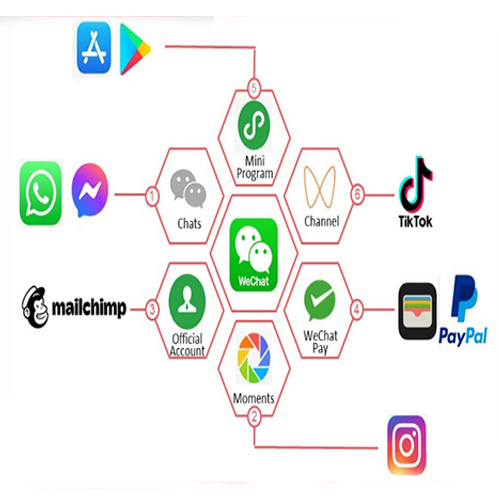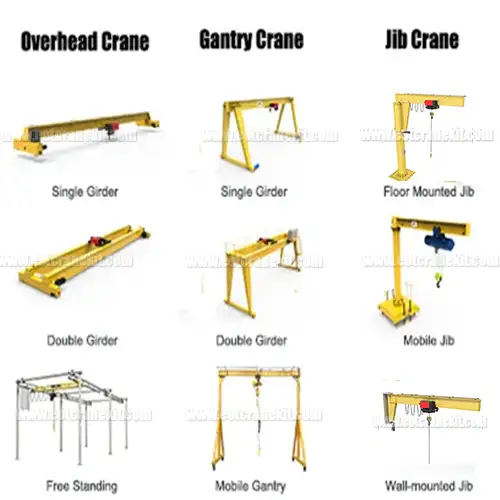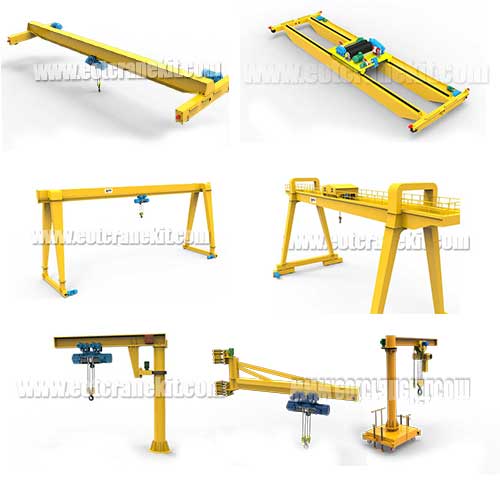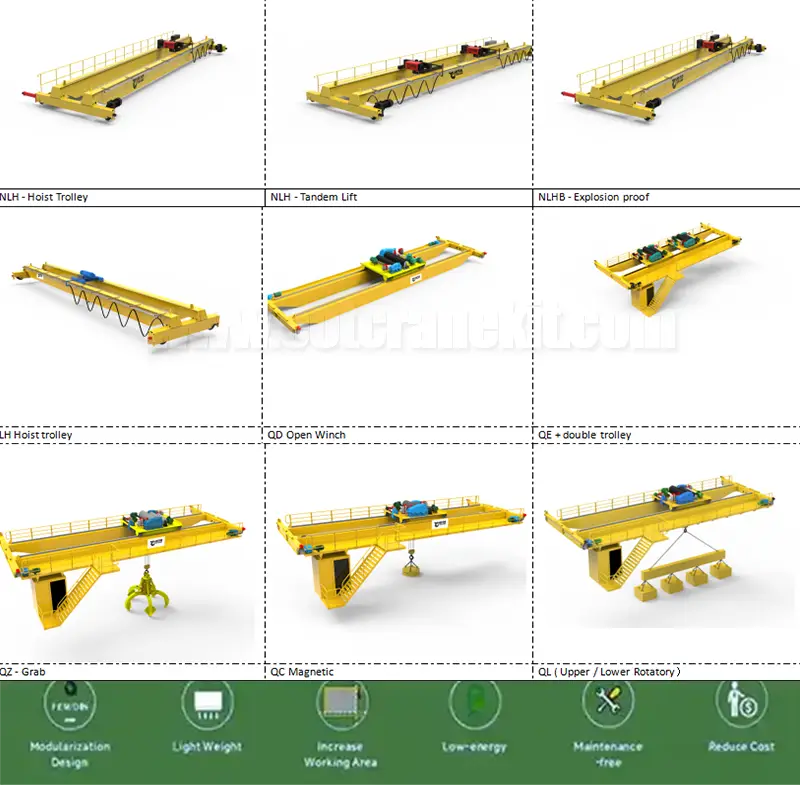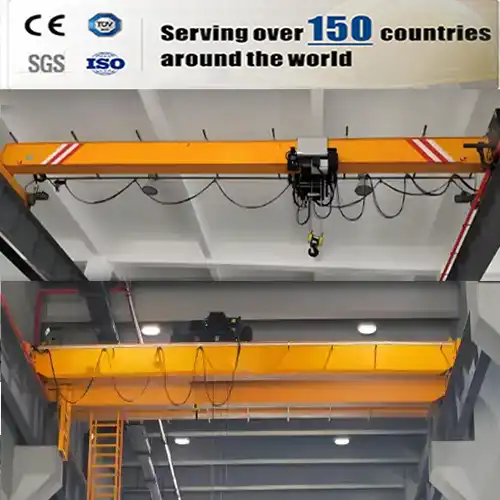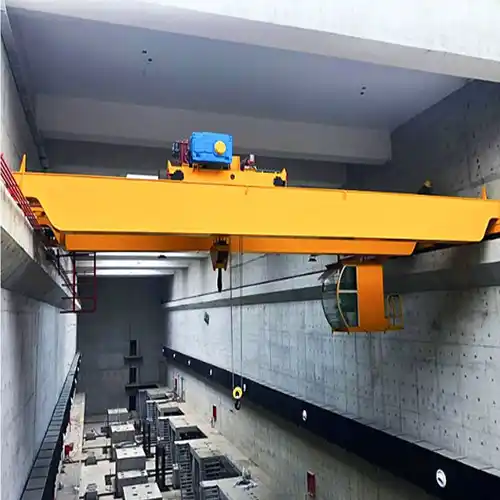Build Bridges with Chinese Crane Manufacturer, Buy Good EOT Crane
Establish effective communication with Chinese crane manufacturers & bridge language & cultural gaps to buy overhead crane from China at good price.
Category: China
Your Trusted Overhead Bridge Crane Manufacturer & Supplier in China
Build Bridges with Chinese Crane Manufacturer, Buy Good EOT Crane
Establish effective communication with Chinese crane manufacturers & bridge language & cultural gaps to buy overhead crane from China at good price.
Importance of Effective Communication
When it comes to establishing successful partnerships and executing projects seamlessly, communication is the cornerstone. This holds especially true when dealing with Chinese crane manufacturers. In this section, we'll delve into why effective communication is of paramount importance in your interactions with these manufacturers and how it can be the key to unlocking fruitful collaborations.
Significance of Clear and Efficient Communication
Clear and efficient communication is the lifeblood of any business relationship, and when you're working with Chinese crane manufacturers, it takes on added importance. Here's why:
- Clarity in Specifications:When you communicate your requirements and specifications clearly, there's less room for misunderstandings or errors in crane design and production. This ensures that the final product aligns perfectly with your needs.
- Timely Updates:Effective communication means you'll receive timely updates on the progress of your crane orders. Whether it's production milestones, shipping details, or any unforeseen delays, staying informed keeps your project on track.
- Problem-Solving:In the event of issues or challenges, open and clear communication channels allow for prompt problem-solving. Whether it's a design modification or addressing a quality concern, the ability to discuss and resolve issues swiftly is invaluable.
- Cultural Understanding:Effective communication goes beyond language; it includes an understanding of Chinese culture. Appreciating cultural nuances in communication can foster better relationships and show respect for your Chinese counterparts.
Types of Overhead Cranes Manufactured in China
Chinese manufacturers produce various types of overhead cranes, each designed for specific applications.
- Bridge cranes are one of the most common types of overhead cranes manufactured in China. They are used to lift and move heavy loads across a factory or warehouse. They consist of a bridge that runs along two parallel rails, with a hoist and trolley system that moves along the bridge.The overhead bridge cranes are mainly classified into single girder overhead crane 1 ton to 20 tons , double girder overhead cranes 3 ton to 320 ton , top running overhead cranes 3 ton to 550 ton , and underslung bridge cranes 1 ton to 10 tons.
- Gantry cranes are similar to bridge cranes but are supported by legs instead of rails. They are commonly used in outdoor applications, such as shipping yards or construction sites.
- Jib cranes are designed for lifting and moving loads in a circular area. They consist of a horizontal beam (jib) that is attached to a vertical mast, with a hoist and trolley system that moves along the jib.
- Monorail cranes are used for moving loads along a single path. They consist of a hoist and trolley system that moves along a single rail, which can be mounted on a ceiling or on a freestanding support structure.
How Effective Communication Drives Success
Now, let's explore how effective communication can translate into successful partnerships and projects:
- Trust and Reliability:When you communicate clearly and consistently, you build trust with your Chinese crane manufacturers. Trust is the foundation of long-term partnerships, and it ensures that both parties can rely on each other.
- Efficiency and Productivity:Clear communication streamlines processes, reduces misunderstandings, and enhances overall efficiency. This translates to faster project completion and reduced costs.
- Risk Mitigation:Effective communication helps identify potential risks early on. By addressing issues proactively, you can mitigate risks and minimize project disruptions.
- Customization:If your project requires specific customizations or modifications, effective communication ensures that your unique needs are met, leading to a crane that perfectly fits your requirements.
In essence, effective communication is not just a means to an end; it's the foundation upon which successful collaborations with Chinese crane manufacturers are built. In the following sections, we'll explore language and cultural considerations, communication channels, negotiation strategies, and how to clear communication barriers to ensure your interactions are as smooth as possible.
Language and Cultural Considerations
In international business, language and culture play pivotal roles in effective communication. When dealing with Chinese crane manufacturers, these considerations become even more significant. In this section, we'll address the language barriers and cultural differences that may arise in your communication and explain how understanding Chinese culture can enhance your business interactions.
China's rich cultural tapestry is interwoven with a diverse array of languages and dialects, presenting both opportunities and challenges for international business interactions. When engaging with Chinese manufacturers, understanding and addressing linguistic diversity is crucial for fostering effective communication and building successful partnerships. This article explores strategies for navigating language differences and maximizing communication clarity in the context of business dealings with Chinese manufacturers.
- Diverse Languages: Embracing Linguistic Diversity: China's linguistic landscape is multifaceted, encompassing a multitude of dialects and regional languages. While Mandarin serves as the official language, it's important to recognize the linguistic diversity that exists within the country. English proficiency may vary among Chinese manufacturers, particularly in smaller or specialized factories. Acknowledging this diversity sets the stage for proactive communication strategies that accommodate varying language capabilities.
- Use of Translators: Bridging the Linguistic Gap: In instances where language disparities pose a communication challenge, leveraging the expertise of professional translators or interpreters can be invaluable. These language experts play a pivotal role in bridging the linguistic gap, ensuring accurate and nuanced communication between parties. By enlisting the services of skilled translators, businesses can facilitate meaningful dialogue and mitigate the potential for misunderstandings arising from language barriers.
- Simplify and Clarify: Effective Communication Principles: Effective communication hinges on the ability to convey messages clearly and comprehensibly. When engaging with Chinese manufacturers, employing clear and concise language becomes paramount. It's essential to avoid the use of idioms, slang, or complex terminology that may not readily translate across languages. By simplifying language and striving for clarity, businesses can enhance the accessibility and impact of their communication, fostering mutual understanding and alignment.
- Embracing Effective Communication Practices: Navigating language differences in business communication with Chinese manufacturers necessitates a thoughtful and inclusive approach. By acknowledging linguistic diversity, embracing the use of professional translators when needed, and prioritizing simplicity and clarity in communication, businesses can fortify their interactions and cultivate enduring partnerships with Chinese manufacturing counterparts. Effective communication practices serve as a cornerstone for transcending language barriers and fostering collaborative success in the global marketplace.
In conclusion, fostering effective communication with Chinese manufacturers demands a proactive approach to navigating language differences. By embracing linguistic diversity, leveraging professional translators, and prioritizing clear and simplified communication, businesses can forge stronger connections and navigate the complexities of cross-cultural communication with confidence and efficacy.
Embracing Cultural Awareness
In business engagements with Chinese partners, understanding and embracing key cultural values and practices is essential for fostering positive and respectful interactions. Here's a detailed exploration of the essential elements of cultural awareness and sensitivity:
- Being Respectful and Polite: In Chinese business culture, demonstrating respect and utilizing formal language is crucial for building strong relationships. - Address individuals by their titles and last names, such as Mr. Zhang or Ms. Li, unless invited to use their first names. - Embracing politeness and courtesy lays the foundation for establishing mutual respect and rapport.
- Understanding Hierarchy and Seniority: Respecting hierarchy and seniority is fundamental in Chinese business culture. - Acknowledge and respect the opinions of senior personnel, emphasizing the importance of deference to senior figures in decision-making processes.
- Taking Time to Build Relationships: Investing time in building trust and strong relationships is pivotal in Chinese business culture. - Engage in multiple meetings, social gatherings, and efforts to understand business partners personally, emphasizing the significance of patience and relationship building.
- Giving Gifts as a Gesture of Goodwill: The practice of giving gifts holds significant meaning in Chinese business culture.When visiting a factory or meeting with business partners, presenting a small, thoughtful gift symbolizes respect and goodwill, fostering a positive impression and laying the groundwork for enduring partnerships.
By embracing these principles of respect, hierarchy, relationship building, and the practice of giving gifts, businesses can effectively navigate cultural nuances and demonstrate a genuine commitment to understanding and respecting the cultural values of their Chinese counterparts, ultimately fostering positive and productive business relationships.
Communication Channels with Chinese Manufacturers
Effectively connecting with Chinese crane manufacturers requires a thoughtful selection of communication channels, and it's essential to consider the devices and platforms that are commonly used today. In this section, we'll explore various options and discuss the pros and cons of different communication methods, along with the popular devices and platforms for each.

Email Communication
Pros:
Asynchronous:Email allows for asynchronous communication, enabling you to send messages and documents at your convenience.
Documentation:It provides a written record of all correspondence, which can be useful for reference and documentation.
Cons:
Possible Delays:Replies may not be immediate, leading to potential delays in decision-making.
Language Barrier:Language differences may be more pronounced in written communication.
Popular Devices and Platforms:
Laptops and desktop computers are commonly used for professional email communication.
Email services like Gmail, Outlook, and Yahoo Mail are popular platforms.

Phone Calls
Pros:
Real-Time:Phone calls offer real-time communication, allowing for immediate clarification of doubts or questions.
Personal Connection:Hearing a voice can help build a personal connection with your counterparts.
Cons:
Time Zone Differences:Scheduling phone calls across different time zones can be challenging.
Language Barrier:Verbal communication may still face language barriers.
Popular Devices and Platforms:
Smartphones are the primary devices for making phone calls.
VoIP (Voice over Internet Protocol) services like Zoom, Skype, and WhatsApp are widely used for international calls.

Video Conferencing
Pros:
Face-to-Face Interaction:Video conferences provide a close approximation of in-person meetings, allowing for visual cues and body language.
Real-Time Collaboration:You can share documents and visuals in real-time, enhancing collaborative discussions.
Cons:
Technical Issues:Video conferencing may encounter technical problems, such as connectivity issues or language challenges.
Scheduling Challenges:Coordinating schedules for international video conferences can be complex.
Popular Devices and Platforms:
Computers with webcams and microphones are used for video conferencing.
Platforms like Zoom, Microsoft Teams, and Google Meet have gained popularity for business video conferencing.

In-Person Meetings
Pros:
Strong Relationship Building:Meeting face-to-face fosters trust and strong relationships.
Clear Communication:It reduces the risk of misunderstandings and allows for immediate feedback.
Cons:
Cost and Time:In-person meetings involve travel expenses and time commitments.
Logistics:Logistics, including visas and accommodation, can be cumbersome.
Popular Devices and Platforms:
In-person meetings require physical presence and do not rely on specific devices or platforms.
Online Chat Tools and Apps
Pros:
Real-Time and Asynchronous:Chat tools like WeChat, WhatsApp, and Skype offer both real-time and asynchronous communication options.
Language Support:Some apps provide translation features, aiding in overcoming language barriers.
Cons:
Privacy Concerns:Using third-party chat apps may raise privacy and security concerns.
Limited for Complex Discussions:While suitable for casual communication, chat apps may not be ideal for complex negotiations.
Popular Devices and Platforms:
Smartphones and tablets are commonly used for chat apps.
WhatsApp, WeChat, Skype, and Telegram are popular platforms for real-time messaging.
Choosing the right communication channel and platform depends on the nature of your interactions and the devices you and your Chinese crane manufacturer counterparts commonly use. A combination of these channels can provide a comprehensive approach to effective communication. In the upcoming sections, we'll explore negotiation strategies, ways to clear communication barriers, and practical tips for seamless interactions, taking into account the communication channels and devices discussed here.
Negotiation Strategies
Negotiating with Chinese crane manufacturers can be a nuanced process, influenced by cultural factors and business practices. In this section, we'll offer valuable tips and strategies for negotiating effectively, ensuring successful outcomes while considering cultural nuances that may impact negotiation dynamics.
Understand Chinese Business Culture
In Chinese business culture, certain key aspects hold significant sway in shaping successful interactions and partnerships. Here's a closer look at the essential elements of understanding and navigating Chinese business culture:
- Relationship Building: In Chinese business culture, the emphasis on strong relationships is paramount. It's crucial to invest time in getting to know your counterparts and building trust before delving into negotiations. Engaging in casual conversation and showing genuine interest can lay the groundwork for enduring and fruitful business relationships.
- Respect for Hierarchy: Chinese companies often adhere to hierarchical structures, where respect for seniority is deeply ingrained. It's important to be mindful of senior personnel and defer to their authority when necessary. Decision-making authority typically rests with senior figures, and acknowledging their status is integral to navigating the dynamics of business interactions.
- Embracing Patience: Negotiations in China may unfold at a slower pace compared to Western cultures. Patience is considered a virtue, and rushing the process can be perceived as a lack of respect for the relationship-building phase. By exercising patience and allowing for the organic development of interactions, businesses can foster a climate of mutual understanding and respect.
By understanding and embracing these fundamental aspects of Chinese business culture, businesses can position themselves to navigate the intricacies of the business landscape in China with grace and acumen, fostering enduring and mutually beneficial partnerships.
Preparation is Key
- Research Your Counterparts: Before engaging in negotiations, it's essential to conduct thorough research on your counterparts. Understanding their background, company history, and their position within the organization can provide valuable insights. This knowledge allows you to tailor your negotiation approach, anticipate their priorities, and establish common ground for productive discussions.
- Set Clear Objectives: Defining your negotiation goals and priorities is crucial for a successful outcome. Clearly outlining what you aim to achieve and articulating your needs with precision sets the stage for focused and effective negotiations. By having a clear understanding of your objectives, you can navigate discussions with confidence and purpose, ensuring that your interests are effectively represented.
- Establish a Strong BATNA: BATNA, which stands for Best Alternative To a Negotiated Agreement, serves as your backup plan in case negotiations fail to yield a satisfactory outcome. Developing a robust BATNA involves identifying alternative options and assessing their viability. Having a strong BATNA not only provides a sense of security but also empowers you with confidence during negotiations, allowing you to make informed decisions and negotiate from a position of strength.
By meticulously preparing through comprehensive research, setting clear objectives, and establishing a robust BATNA, businesses can equip themselves with the tools and insights necessary to navigate negotiations effectively and maximize the potential for successful outcomes.
Effective Communication
In effective communication during business negotiations, certain key principles play a pivotal role in fostering clarity and understanding. Here's a closer look at the essential elements of effective communication:
- Clear and Concise Language: Utilizing straightforward language to convey your points is essential for ensuring clarity and minimizing the potential for misinterpretation. Avoiding ambiguity and indirect communication helps in articulating your positions with precision, enabling all parties to comprehend the intended message effectively.
- Active Listening: Actively listening to your counterparts is a fundamental aspect of effective communication. Paying close attention to their perspectives and concerns demonstrates respect and understanding. By actively engaging in attentive listening, you can gain valuable insights, foster rapport, and demonstrate a genuine commitment to mutual understanding.
- Use of Written Agreements: Documenting agreed-upon terms in writing is crucial for establishing a clear and unambiguous record of the negotiated terms. Utilizing written agreements helps in avoiding misunderstandings and disputes in the future. Detailed and explicit contracts serve as essential tools for formalizing the terms of the agreement and ensuring alignment among all parties involved.
By embracing the principles of clear and concise language, active listening, and the utilization of written agreements, businesses can fortify their communication strategies and enhance the efficacy of their negotiations, ultimately contributing to the establishment of robust and mutually beneficial agreements.
Bargaining and Concessions
In the context of bargaining and concessions during business negotiations, several fundamental principles contribute to the cultivation of productive and respectful discussions. Here's an exploration of the essential elements of bargaining and concessions:
- Start Conservatively: Initiating negotiations with a conservative offer or request allows for flexibility and creates space for concessions. This approach demonstrates a willingness to engage in constructive dialogue and adapt to the evolving dynamics of the negotiation process.
- Maintain Face: In Chinese culture, the concept of "saving face" and preserving dignity holds significant importance. It's crucial to navigate negotiations with sensitivity, avoiding direct confrontation or criticism. Framing feedback and disagreements tactfully contributes to maintaining a harmonious and respectful negotiation environment.
- Reciprocity: Embracing a give-and-take negotiation style fosters an environment of reciprocity and collaboration. Being prepared to offer small concessions can serve as a catalyst for encouraging counterparts to reciprocate, ultimately contributing to the cultivation of mutually beneficial agreements.
By integrating these principles of starting conservatively, maintaining cultural sensitivity, and embracing reciprocity, businesses can navigate negotiations with grace and acumen, fostering an environment of respect and cooperation while working towards achieving mutually satisfactory outcomes.
Finalizing the Deal
In the final stages of finalizing a business deal, certain key actions can contribute to the successful conclusion of negotiations and the cultivation of enduring partnerships. Here's a closer look at the essential elements of finalizing the deal:
- Consult Legal Expertise: Engaging legal professionals with experience in international business transactions to review contracts and agreements is crucial. Their expertise ensures that the finalized deal aligns with legal requirements and safeguards the interests of all parties involved, contributing to the establishment of a solid and legally sound agreement.
- Express Appreciation: After reaching an agreement, expressing gratitude and enthusiasm for the partnership reinforces the positive relationship. Demonstrating appreciation for the collaborative efforts and expressing eagerness for the future partnership fosters a climate of mutual respect and goodwill.
- Follow Up: Maintaining open lines of communication after the deal is concluded is essential for nurturing and strengthening the partnership. Regular check-ins and ongoing communication serve to reaffirm commitment, address any potential issues, and sustain the positive momentum established during the negotiation process.
By embracing these principles of consulting legal expertise, expressing appreciation, and maintaining open lines of communication, businesses can effectively navigate the finalization of the deal, fortify the partnership, and lay the groundwork for enduring and successful collaborations.
Cultural Sensitivity
In cultural sensitivity, understanding and embracing key cultural practices and customs is essential for fostering positive and respectful interactions. Here's a closer look at the essential elements of cultural sensitivity:
- Language and Etiquette: Learning basic Mandarin phrases and observing Chinese etiquette, such as respectfully exchanging business cards, demonstrates a genuine effort to understand and respect the cultural norms of your Chinese counterparts. Embracing these practices contributes to building rapport and fostering a climate of mutual respect.
- Gift Giving: Offering a small gift, particularly one with cultural significance from your country, can be a thoughtful gesture that symbolizes goodwill and respect. Thoughtfully chosen gifts serve as tokens of appreciation and contribute to the cultivation of positive business relationships.
- Dining Etiquette: If dining with your counterparts, being aware of Chinese dining customs, including toasting and seating arrangements, demonstrates cultural awareness and respect. Observing these customs contributes to creating a harmonious and respectful dining experience, fostering a positive impression and reinforcing the value of cultural sensitivity.
By embracing these principles of language and etiquette, gift giving, and dining customs, businesses can demonstrate cultural sensitivity, foster positive interactions, and lay the groundwork for enduring and respectful business relationships.
By integrating these negotiation strategies and cultural considerations into your interactions with Chinese crane manufacturers, you can build strong partnerships and navigate the complexities of international business successfully. In the following sections, we'll explore ways to clear communication barriers and provide practical tips for seamless interactions, enhancing your ability to negotiate effectively and achieve your business objectives.
Clearing Communication Barriers
Effective communication with Chinese crane manufacturers can be both rewarding and challenging, especially when language and cultural barriers come into play. In this section, we'll provide practical advice for overcoming these communication challenges and share real-world examples and success stories of bridging language and cultural gaps.
In today's global business landscape, effective cross-cultural communication is essential for fostering successful partnerships and collaborations with Chinese counterparts. Embracing a comprehensive set of strategies, including technological tools, professional interpretation services, visual aids, cross-cultural training, patience, empathy, and relationship building, provides a roadmap for navigating the complexities of engaging with Chinese partners. This article delves into the multifaceted strategies essential for effective cross-cultural communication with Chinese counterparts.
Embrace Technology and Translation Tools
Leveraging technology and translation tools is pivotal for overcoming language barriers and fostering effective communication:
Online Translation Apps: Utilize online translation tools like Google Translate to instantly translate text or speech, supporting Mandarin Chinese for enhanced accessibility.
Language Learning Apps: Invest time in learning basic Mandarin phrases using apps like Duolingo and Rosetta Stone for convenient language learning options, empowering individuals to develop fundamental language proficiency.
Engage Professional Interpreters
The utilization of professional interpretation services serves as a cornerstone for ensuring accurate and clear communication:
On-Site Interpreters: Consider hiring professional interpreters fluent in both Mandarin and your language for critical meetings or negotiations, ensuring precise and effective communication.
Remote Interpretation Services: Leverage remote interpretation services via video conferencing platforms to bridge language gaps effectively in the digital age, facilitating seamless communication across geographical boundaries.
Visual Aids and Documentation
Utilizing visual aids and comprehensive documentation enhances the clarity and understanding of communication:
Visual Communication: Employ visual aids, charts, and diagrams to supplement verbal communication, enabling the effective conveyance of complex ideas.
Document Everything: Put important information in writing, including specifications, expectations, and agreements, providing a clear reference point for both parties and mitigating misunderstandings.
Cross-Cultural Training
Investing in cross-cultural training and learning from success stories contributes to a deeper understanding of Chinese culture and business etiquette:
Cultural Sensitivity Workshops: Participate in or organize cultural sensitivity workshops to gain valuable insights into Chinese culture and business etiquette, fostering a climate of mutual respect and understanding.
Learn from Success Stories: Study success stories of businesses that have effectively navigated cross-cultural communication, drawing valuable lessons from their experiences and applying them to enhance engagement with Chinese counterparts.
Patience and Empathy
The cultivation of patience and empathy is fundamental for fostering empathetic and understanding communication:
Be Patient: Recognize that misunderstandings may occur, maintaining a positive attitude while avoiding frustration, contributing to a harmonious negotiation environment.
Cultivate Empathy: Put yourself in the shoes of your Chinese counterparts, understanding their perspective for more empathetic communication, fostering mutual understanding and respect.
Build Strong Relationships
Investing in relationship building and shared experiences forms the bedrock for enduring and successful partnerships:
Invest Time in Relationship Building: Engage in small talk, show genuine interest in your counterparts, and make an effort to get to know them on a personal level, fostering a climate of mutual respect and trust.
Shared Experiences: Finding common interests or experiences to discuss can create a stronger bond, fostering a deeper understanding and connection, ultimately contributing to the cultivation of enduring and successful partnerships.
In conclusion, the adoption of a holistic approach encompassing technological tools, professional interpretation services, visual aids, cross-cultural training, patience, empathy, and relationship building serves as a blueprint for navigating effective cross-cultural communication with Chinese counterparts. By embracing these strategies, businesses can foster a climate of mutual understanding, respect, and collaboration, laying the foundation for enduring and successful partnerships in the global marketplace.
By embracing these strategies, businesses can effectively navigate cross-cultural communication with Chinese counterparts, fostering positive interactions and cultivating enduring and successful partnerships.
Popular Online Chat Tools and Apps in China
In today's interconnected world, effective communication is essential for successful business interactions, especially when collaborating with international partners such as Chinese manufacturers. Online chat tools and apps play a pivotal role in facilitating real-time communication, bridging geographical gaps, and overcoming language barriers. This article introduces the significance of online chat tools and recommends popular platforms like WeChat, WhatsApp, and Skype for connecting with Chinese manufacturers.
- The Significance of Online Chat Tools: Online chat tools and apps have revolutionized the way individuals and businesses communicate. These platforms offer a diverse range of features that enable real-time messaging, voice calls, video calls, file sharing, and group discussions. The convenience and accessibility of these tools have made them indispensable for fostering seamless communication across borders.
- Connecting with Chinese Manufacturers: When engaging with Chinese manufacturers, the ability to communicate effectively is crucial for building strong partnerships and ensuring the success of collaborative projects. Platforms such as WeChat, WhatsApp, and Skype are widely used in China and offer comprehensive communication solutions. By leveraging these tools, businesses can establish direct lines of communication with manufacturers, facilitating swift decision-making and problem-solving.
- Streamlining Communication Across Language Differences: One of the most significant challenges in international business dealings is overcoming language barriers. Online chat tools equipped with translation features can significantly ease this challenge. For instance, WeChat offers real-time translation capabilities, allowing users to communicate seamlessly in their preferred languages. This feature is particularly valuable when negotiating terms, discussing technical specifications, or clarifying intricate details with Chinese manufacturers.
- Enhancing Collaboration and Efficiency: The use of online chat tools and apps enhances collaboration and efficiency in business interactions. Through instant messaging and multimedia sharing, stakeholders can exchange ideas, share visual representations of products, and provide timely feedback. This streamlined communication process fosters a deeper understanding between parties and accelerates the decision-making process, ultimately expediting project timelines and increasing productivity.
In conclusion, online chat tools and apps are invaluable assets for businesses seeking to connect with Chinese manufacturers and streamline communication processes. By leveraging platforms such as WeChat, WhatsApp, and Skype, businesses can overcome geographical and language barriers, fostering stronger relationships and facilitating smoother collaboration. As the global marketplace continues to evolve, embracing these digital communication tools is essential for staying competitive and establishing successful partnerships with manufacturers worldwide.

WeChat is a multifunctional messaging, social media, and mobile payment app developed by the Chinese company Tencent. It has become one of the most popular and widely used social platforms in China, offering a diverse range of features that go beyond traditional messaging. Here are some key aspects of WeChat:
- Messaging and Voice/Video Calling: WeChat allows users to send text and voice messages to individuals or groups. It also supports voice and video calling, enabling real-time communication with contacts.
- Moments: WeChat's "Moments" feature functions as a social feed where users can share photos, videos, and status updates with their contacts, similar to a timeline on other social media platforms.
- Official Accounts: WeChat provides a platform for businesses, organizations, and individuals to create official accounts for sharing content, promoting products or services, and engaging with followers.
- Mini Programs: WeChat's mini programs are small applications that run within the WeChat app, offering a wide range of services such as e-commerce, food delivery, transportation, and more, without the need to download separate apps.
- Mobile Payment: WeChat Pay, integrated into the WeChat app, allows users to make mobile payments, transfer money to friends, pay bills, and purchase goods and services at offline and online merchants.
- WeChat Wallet: The app includes a digital wallet feature for managing financial transactions, including storing bank cards, making investments, and managing personal finances.
- Sticker Gallery and Games: WeChat offers a wide selection of stickers for messaging, as well as a variety of mini-games that users can play within the app.
WeChat's diverse functionalities make it an all-in-one platform for communication, social networking, and mobile commerce. It has become an integral part of daily life for many people in China, serving as a primary means of staying connected with friends, accessing services, and conducting financial transactions.
DingTalk
DingTalk is a popular communication and collaboration platform developed by Alibaba Group, catering to the needs of businesses and organizations. It offers a wide range of features designed to streamline communication, enhance productivity, and facilitate seamless collaboration among team members. Some key aspects of DingTalk include:
- Messaging and Voice/Video Calling: DingTalk provides instant messaging functionality for one-on-one and group conversations. In addition, it offers voice and video calling features, allowing users to engage in real-time audio and video communication within the platform.
- Task Management and Scheduling: The platform includes tools for task assignment, tracking, and scheduling, enabling teams to organize and manage their work efficiently. Users can create and assign tasks, set deadlines, and monitor progress within the platform.
- File Sharing and Collaboration: DingTalk facilitates file sharing and collaborative document editing, allowing team members to share files, documents, and multimedia content. It supports the seamless exchange of information and resources within the organization.
- Attendance and Leave Management: For businesses, DingTalk offers features for attendance management, leave requests, and approval workflows. This helps organizations to effectively manage employee schedules and leave arrangements.
- Integration with Third-Party Apps: DingTalk can be integrated with various third-party applications, allowing users to access additional functionalities and services directly within the platform.
- Video Conferencing and Live Streaming: The platform supports video conferencing and live streaming, making it suitable for virtual meetings, webinars, and remote collaboration.
Overall, DingTalk serves as a comprehensive platform for internal communication, project management, and team collaboration within businesses and organizations. It is designed to enhance efficiency, streamline workflows, and facilitate effective communication among team members, making it a valuable tool for modern workplaces.


QQ is a popular instant messaging software developed by the Chinese tech company Tencent. It offers a wide range of communication features and has been widely used in China and other parts of the world. Here are some key aspects of QQ:
- Instant Messaging: QQ provides users with the ability to send text messages, voice messages, and files to individuals and groups. It supports real-time communication through text-based conversations.
- Voice and Video Calling: The platform includes voice and video calling features, allowing users to engage in audio and video conversations with their contacts.
- Social Networking: QQ offers social networking features, including the ability to add friends, update personal profiles, share photos, and join interest-based groups and communities.
- Online Gaming: QQ has an integrated gaming platform that allows users to play a variety of online games with their friends and other users.
- QQ International: QQ International is an English-language version of QQ, designed to cater to an international audience, particularly users outside of China.
- Customizable Avatars and Themes: Users can personalize their profiles with custom avatars, themes, and backgrounds, adding a personal touch to their messaging experience.
- File Sharing: QQ enables users to share files, documents, and multimedia content, facilitating the exchange of information and resources.
QQ has been a prominent player in the realm of instant messaging and has evolved to offer a comprehensive set of features for communication, social interaction, and entertainment. It has maintained a strong user base and continues to be a popular choice for individuals seeking to connect with others and engage in various online activities.
WhatsApp:
- WhatsApp, a widely used messaging app owned by Facebook, is also popular among international business professionals for communication with their counterparts in China. While WhatsApp is not as widely used within mainland China due to certain restrictions, it remains a preferred choice for international communication and collaboration with Chinese business partners and clients.
- WhatsApp offers a range of features such as text messaging, voice calls, video calls, and file sharing, making it a versatile platform for real-time communication. Its user-friendly interface and widespread global adoption make it an attractive option for international business communication, including interactions with counterparts in China.
- Many international business professionals appreciate the convenience and reliability of WhatsApp for maintaining direct lines of communication, sharing updates, discussing business matters, and building relationships with their Chinese contacts. Additionally, the platform's encryption and security features provide a level of privacy and data protection that is valued in the business context.
- Overall, WhatsApp's popularity among international business professionals extends to their interactions with counterparts in China, contributing to its role as a key communication tool for global business engagements.

If you have any hoist or crane , please feel free to contact us. If you have any problem on communication with Chinese parteners or need any help on online talking apps download, please feel free to contact us by whatsapp, we are willingly to help you and the needed app packages will be send to you for free .
Related Products
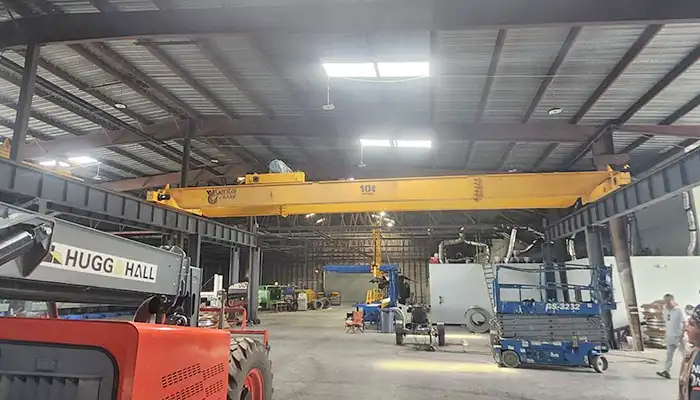
Affordable 10 ton double girder overhead crane with CD/MD hoist trolley, built for U.S. standards, ideal for construction and industrial lifting
Free consultation to Confirm Parameters & Specifications and Get
Latest Crane Price & Crane Rate.
- Types of overhead cranes : _______?
- Optional: Overhead travelling crane, goliath gantry crane,Slewing jib crane, Single girder or double girder crane,small portable crane or kbk crane, etc.
- Capacity of overhead crane: _______?
- Optional: 0.25ton, 0.5 ton, 1 ton, 2 ton, 3ton, 5 ton, 10 ton,15ton, 20ton, 25 ton, 30ton,35ton, up to 550ton, etc.
- Crane span & lifting height : _______?
- Crane travelling length : _____?
- Control of overhead crane:_______?
- Optional: pendant/ remote/cabin control
- Voltage supply of overhead crane:_____?
- Eg,: 380V50/60HZ,3Phase or others,etc.
- Application/usage of crane:_______?
- Eg,: Steel mill, ,injection mold, cement,stone, concrete,granite, general manufacturing, etc.
Just leave a message via the contact form and our hoist and crane engineer will contact you with in 24working hours.
Get In Touch
